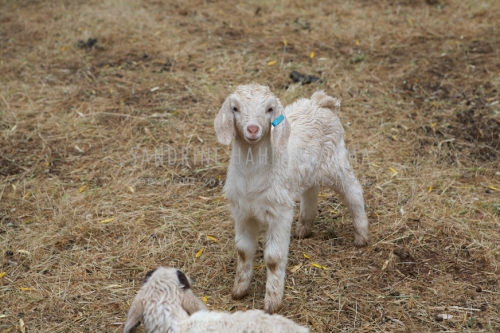Great share by: Stone Cottage Farm
 |
Goats are among the earliest domesticated animals.
65%-72% of the world’s population drinks goat’s milk. In many countries in the world, goat’s milk is preferred to cow’s milk. Goats are naturally immune to diseases, such as tuberculosis, and are used in some countries to actually cure tuberculosis because of their inherent antibodies. India, Bangladesh and the Sudan are large producers. Even in the United States, the goat is gaining popularity. Goats eat less and occupy less grazing space than cows, and in some families the backyard goat supplies milk for family needs.What does goat’s milk give you that cow’s milk doesn’t? Goat’s milk is believed to be more easily digestible and less allergenic than cow’s milk.

According to the Journal of American Medicine, “Goat’s milk is the most complete food known.” It contains vitamins, minerals, electrolytes, trace elements, enzymes, protein, and fatty acids that are utilized by your body with ease. In fact, your body can digest goat’s milk in just 20 minutes. It takes 2-3 hours to digest cow’s milk. It contains relatively high levels of tryptophan, calcium, Vitamin D, phosphorus, Vitamin B2, protein, and potassium.

Excerpt from “The Maker’s Diet” by Jordan S. Rubin. ’You shall have enough goats’ milk for your food, for the food of your household, and the nourishment of your maidservants’ (Proverbs 27:27).
The milk consumed in biblical times differed much from the milk we consume today. The milk of the Bible came from cows and goats and was consumed straight from the animal (it was not pasteurized or homogenized), or it was immediately fermented. These ‘live’ foods provide excellent health benefits in contrast to today’s pasteurized, homogenized, often skimmed and ‘refortified’ milk, which is not only less nutritious but also can be potentially harmful and a major cause of allergies and even heart disease. (pg 147)
Dr. Sears disassembles goat’s milk, nutrient-by-nutrient, to see how it compares with cow’s milk.
Different fat. Goat’s
milk contains around ten grams of fat per eight ounces compared to 8 to 9
grams in whole cow’s milk, and it’s much easier to find lowfat and
non-fat varieties of cow’s milk than it is to purchase lowfat goat’s
milk. Unlike cow’s milk, goat’s milk does not contain agglutinin. As a
result, the fat globules in goat’s milk do not cluster together, making
them easier to digest. Like cow’s milk, goat’s milk is low in essential
fatty acids, because goats also have EFA-destroying bacteria in their
ruminant stomachs. Yet, goat milk is reported to contain more of the
essential fatty acids linoleic and arachnodonic acids, in addition to a
higher proportion of short-chain and medium-chain fatty acids. These are
easier for intestinal enzymes to digest.
Different protein. Goat
milk protein forms a softer curd (the term given to the protein clumps
that are formed by the action of your stomach acid on the protein),
which makes the protein more easily and rapidly digestible.
Theoretically, this more rapid transit through the stomach could be an
advantage to infants and children who regurgitate cow’s milk easily.
Goat’s milk may also have advantages when it comes to allergies. Goat’s
milk contains only trace amounts of an allergenic casein protein,
alpha-S1, found in cow’s milk. Goat’s milk casein is more similar to
human milk, yet cow’s milk and goat’s milk contain similar levels of the
other allergenic protein, beta lactoglobulin. Scientific studies have
not found a decreased incidence of allergy with goat’s milk, but here is
another situation where mothers’ observations and scientific studies
are at odds with one another. Some mothers are certain that their child
tolerates goat’s milk better than cow’s milk, and mothers are more
sensitive to children’s reactions than scientific studies.
Less lactose. Goat’s milk
contains slightly lower levels of lactose (4.1 percent versus 4.7
percent in cow’s milk), which may be a small advantage in
lactose-intolerant persons.
Different minerals. Although
the mineral content of goat’s milk and cow’s milk is generally similar,
goat’s milk contains 13 percent more calcium, 25 percent more vitamin
B-6, 47 percent more vitamin A, 134 percent more potassium, and three
times more niacin. It is also four times higher in copper. Goat’s milk
also contains 27 percent more of the antioxidant selenium than cow’s
milk. Cow’s milk contains five times as much vitamin B-12 as goat’s milk
and ten times as much folic acid (12 mcg. in cow’s milk versus 1 mcg.
for goat’s milk per eight ounces with an RDA of 75-100 mcg. for
children). The fact that goat’s milk contains less than ten percent of
the amount of folic acid contained in cow’s milk means that it must be
supplemented with folic acid in order to be adequate as a formula or
milk substitute for infants and toddlers, and popular brands of goat’s
milk may advertise “supplemented with folic acid” on the carton.
SourcesDr. Sears http://www.askdrsears.com/topics/feeding-infants-toddlers/goat-milk
Cow’s Milk vs. Goat’s Milk http://altmedangel.com/milkcomp.htm
Benefits of Raw http://igreennutrition.com/topics/the-benefits-of-raw-and-fermented-goats-milk-and-cows-milk
Overall Benefits http://www.roseofsharonacres.com/raw_goat_milk_benefits
Photographs captured by Sandrine Hahn earlier this month at Chaffin Family Orchards



No comments:
Post a Comment
Do To the enormous amounts of spam I will no longer take the time to moderate Anyone posting under anonymous... Sorry for the inconvenience but my email is blasted everyday with 40 to 50 anonymous posts that are junk mail. I just don't have the time to read each one before deleting.